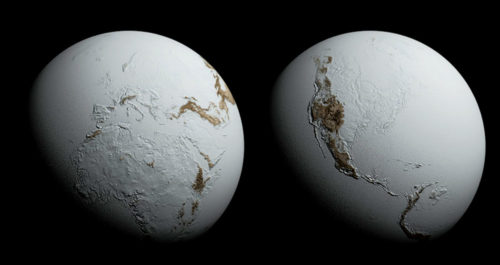
Imagine the entire earth covered in ice. It’s not that far-fetched. It actually happened—and more than once.
Was it because Anna got mad at Elsa? No—but the real reason is even cooler. Scientists only figured it out after a rather provocative hypothesis tied a bunch of bizarre evidence together.
The first clues were discovered on some desolate Atlantic islands. There geologists found layers of rock formed by glaciers, but sandwiched between tropical rocks. How had this happened? Did the islands tectonically drift from the tropics to the poles and then back?
Nope. Microscopic magnetic particles in the rocks showed that when they were originally deposited, the rocks were located near the equator. This could only mean one thing—that the tropics had once been covered by ice.
No problem, you say? There are glaciers atop plenty of equatorial mountains, like the ones that feed the Nile or that dot Ecuadorian rainforests. Maybe such high-elevation glaciers could explain the equatorial ice evidence geologists were finding.

Imagine the earth enveloped in ice, as it was during Snowball Earth times, hundreds of millions of years ago. Image: Neethis
Except that the tropical strata below and above the glacial rocks weren’t deposited at high elevation. Rather, they were deposited in warm water, near tidal flats and ocean beaches.
It gets even crazier. In other reaches of the globe, scientists scratched their heads about similarly bipolar deposits—in Australia, Africa, Asia, and our own Rocky Mountains. Much like paleontologists figured out that dinosaurs all disappeared at the same time, it took a long time for geologists to figure out that all these glacial-tropical rocks were about the same age.
Meaning: Maybe the entire planet, even delightful places like Ecuador, had once been covered by vast sheets of ice. A Snowball Earth!
Such a preposterous hypothesis wouldn’t have stood a chance if it hadn’t been grounded in some seemingly unrelated Cold War science. A climate model, produced by a Soviet physicist trying to figure out the impacts of society’s CO2 emissions, provided one key element. It showed that if our polar ice caps grew to within about 30 degrees of the equator (think: Houston), so much of the sun’s radiation would be reflected by ice that the planet’s capacity to melt ice would be exceeded by the rate at which it produced and built it up. Like a runaway freight train, ice caps would grow unabated, eventually extending all the way to the equator and enveloping the earth in an apocalyptic winter.
Pre-Snowball, the earth’s continental plates had become amalgamated in a giant supercontinent that straddled the equator. This configuration had two impacts. The first was that it reduced absorption of much of the sun’s heat that is normally absorbed by equatorial oceans. The second was that the intense rainfall in the tropics broke down mountains, rocks and soils faster—a process that sucks planet-warming CO2 out of the atmosphere. When you couple this one-two combo with the fact that the ancient sun was fainter, it could have cooled the earth, triggering one of those runaway ice ages, where polar ice grew unchecked until it blanketed the planet.
To break out of this icy trap, greenhouse gases like CO2 and methane, regularly belching out of volcanoes, needed to build up in the atmosphere. Based on the chemistry of lime-rich, tropical rocks that overlie the glacial deposits, greenhouse gas concentrations rose to over 350 times present-day levels! Such concentrations would have been able to absorb enough heat from the sun’s incoming rays to melt the globe’s icy blanket and break us out of Snowball Earth.

Rocks like these ones, exposed in the Uinta Mountains of Colorado and Utah, signal times when our planet was a Snowball Earth.
Image: J. Whiteley
Nature tends to repeat herself. As evidence mounts for tying all these oddities together, we’ve learned that there were likely more than one of these Snowball Earth events.
The oldest ones have their remnants all around you. That’s because most of society’s iron and manganese, elements used to make steel and inhibit corrosion in beer cans, were deposited during Snowball times. With the oceans capped by ice, dissolved iron and manganese vented from seafloor fissures had nowhere to go. Seawater concentrations reached epic levels, and this metallic stew periodically precipitated out onto the seafloor, forming colossal metal deposits.
Out of the ashes of the last apocalyptic Snowball Earth event came life. During that event, rather than just metals building up, the key life-supporting nutrient phosphorous built up in the oceans. When the Snowball broke, photosynthesizing algae bloomed in preposterous proportions, boosting the ocean’s and atmosphere’s oxygen levels far beyond what the planet had seen before. This now-abundant waste product likely helped some rather innocuous multi-celled creatures start moving around and explode in diversity and size: the first animals.
James Hagadorn, Ph.D., is a scientist at the Denver Museum of Nature & Science.
Suggestions and comments are welcome at jwhagadorn@dmns.org.




0 Comments